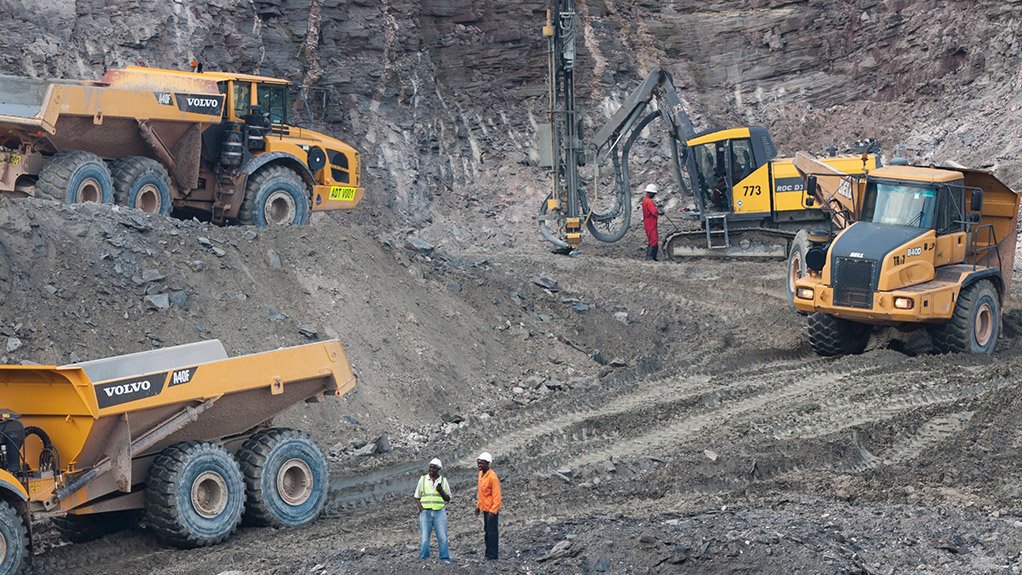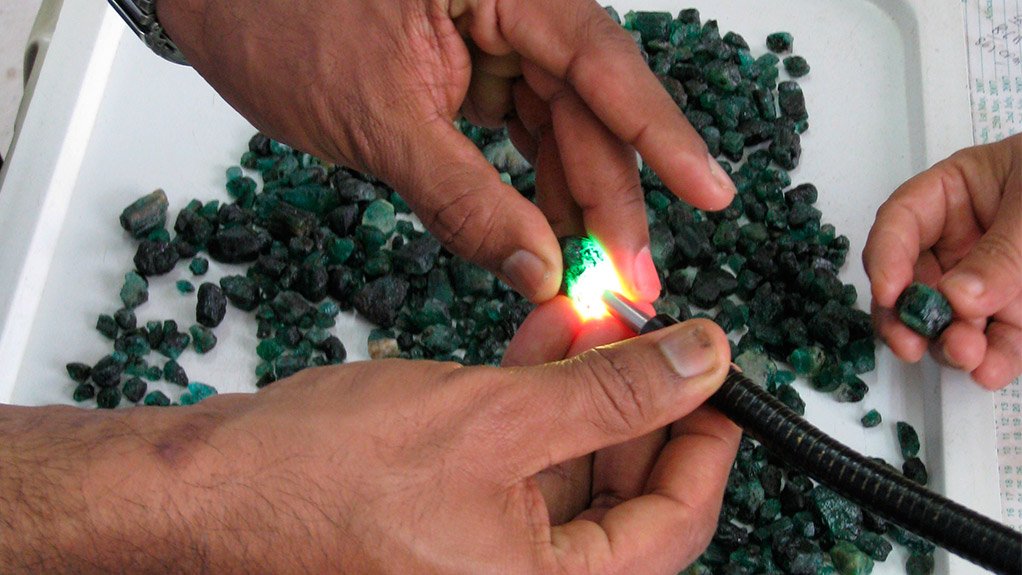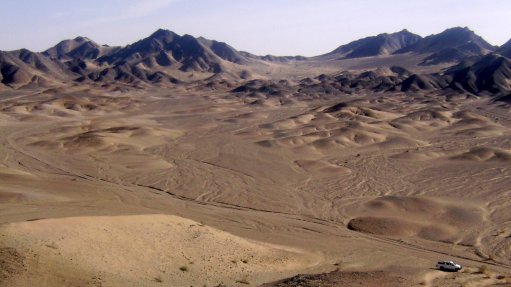Gemfields targeting higher gemstones production this year



CHAMA PIT, KAGEM MINE Kagem produces about 253 ct of emerald and beryl per tonne of material mined
EXPANSION AIMS Gemfields hopes to soon add a Colombian emerald mining operation to its portfolio of companies
Coloured gemstone mining and marketing company Gemfields is targeting the production of about 25-million carats of emerald and beryl from its Kagem mine, in Zambia, and about eight-million carats of ruby and corundum from its Montepuez mine, in Mozambique, this year.
Gemfields owns a 75% stake in the Kagem mine, the licence area of which covers about 41 km2.
Gemfields CEO Ian Harebottle tells Mining Weekly that Kagem contains several emerald-bearing belts.
“One portion of the licence area contains our large-scale mining operation, two of the other areas are in the bulk-sampling phase, while several other sections . . . have as yet not been fully explored,” he says.
During the 2013/14 financial year, Kagem produced 20.2-million carats of emerald and beryl from its Chama pit, while also securing revenues of $87.8-million, with operating profits of $49.8-million.
Additionally, during the first quarter of the 2014/15 financial year, Kagem produced 6.3-million carats of emeralds.
Harebottle points out that Kagem produces about 253 ct of emerald and beryl per tonne of material mined with the historic five-year average trending as high as 300 ct per tonne.
“In January, we increased our level of exploration activity across the licence area by undertaking additional diamond core drilling and bulk sampling. Gemfields is hopeful that our current focus on Kagem’s Fibolele and Libwente pits will start to deliver some positive results over the coming months,” he says.
Gemfields also owns 75% of the Montepuez mine, which produced 6.5-million carats of ruby and corundum, with revenues of $33.5- million and an operating profit of $16.6-million during the 2013/14 financial year.
Further, during the first quarter of the 2014/15 financial year, the mine produced 2.9-million carats of ruby and corundum.
However, Harebottle highlights that Montepuez is still in the exploration phase and Gemfields plans to ramp up production at the mine over the next 18 months, which will require the installation of a considerably larger washing plant and the appointment of a contractor to manage the waste mining.
He points out that, in October 2014, Gemfields bought an additional ruby deposit, adjacent to the Montepuez ruby deposit and which the company intends to use to expand Montepuez’s existing operations in the long term.
Meanwhile, Gemfields entered into a joint venture (JV) agreement with Jersey-registered East West Gem Investments in November 2014 to progress opportunities in the Sri Lankan sapphire and gemstone sector.
Gemfields owns 75% and East West Gem Investments 25% of the JV.
Harebottle tells Mining Weekly that the company is hoping to add a Colombian emerald mining operation to its portfolio of companies within the next year or so and should make an announcement concerning this undertaking “in due course”.
“We are also working on increasing the scale and diversity of our auction platform. Gemfields intends to allow for other producers’ gemstones to be offered from the same selling platform, thereby ensuring maximum value for all producers (large and small), increased reliability and volumes of supply to the downstream market and complete compliance regarding the payment of associated royalties and taxes to our companies’ host nations.”
He adds that the company’s cut and polished division aims to assist in increasing the sector’s overall sales and distribution volumes of finished gemstones, particularly those produced by some of Gemfields’ auction partners.
African Analysis
Harebottle tells Mining Weekly that while there is a “measured increase” in demand for gemstones from Nigeria and South Africa, Africa as a whole is not yet an “overly important” market with regard to finished goods consumption.
However, he believes that Africa has the potential to play a significant role in terms of production volumes.
“The gemstones industry worldwide, not only in Africa, has been a largely erratic sector to date, with little formal investment in equipment, infrastructure or technology. It is dominated by artisanal mining, thus making it difficult to provide any numbers with a high level of accuracy, besides those supplied by Gemfields in terms of our production, sales and revenues.”
He notes that jewellery market information provider Gemworld’s Gemguide estimated that about 30% of the world’s emeralds are produced in Africa, mainly in Zambia.
“Our Montepuez ruby mine has the potential to be the worlds largest single source of rubies and we estimate that it has the potential to produce as much as 30% of global ruby supplies over the next three to five years,” says Harebottle.
He highlights that Madagascar produces high-quality sapphires, but no statistics are available regarding the volumes and value of the goods produced.
“Tanzania is another important coloured-gemstone-producing country, and is mainly known for tanzanite, tsavorite and corundum,” Harebottle states, but adds that the volumes produced and exported have decreased over the past five years.
He believes that Africa’s coloured gemstone mining sector needs to be treated with the same respect as any other mineral resource sector, particularly if governments on the continent hope to achieve “true long-term value from these rare gems”.
“Our sector requires the formulation of rules and regulations that take into consideration the unique challenges that sustainable coloured gemstone mines face and for these rules to be applied fairly and consistently to all stakeholders over the long term. Inappropriate and poorly thought through regulations can easily result in value erosion, rather than value addition, with an unfortunately large number of examples readily available throughout Africa over the past 10 to 20 years,” Harebottle concludes.
Comments
Press Office
Announcements
What's On
Subscribe to improve your user experience...
Option 1 (equivalent of R125 a month):
Receive a weekly copy of Creamer Media's Engineering News & Mining Weekly magazine
(print copy for those in South Africa and e-magazine for those outside of South Africa)
Receive daily email newsletters
Access to full search results
Access archive of magazine back copies
Access to Projects in Progress
Access to ONE Research Report of your choice in PDF format
Option 2 (equivalent of R375 a month):
All benefits from Option 1
PLUS
Access to Creamer Media's Research Channel Africa for ALL Research Reports, in PDF format, on various industrial and mining sectors
including Electricity; Water; Energy Transition; Hydrogen; Roads, Rail and Ports; Coal; Gold; Platinum; Battery Metals; etc.
Already a subscriber?
Forgotten your password?
Receive weekly copy of Creamer Media's Engineering News & Mining Weekly magazine (print copy for those in South Africa and e-magazine for those outside of South Africa)
➕
Recieve daily email newsletters
➕
Access to full search results
➕
Access archive of magazine back copies
➕
Access to Projects in Progress
➕
Access to ONE Research Report of your choice in PDF format
RESEARCH CHANNEL AFRICA
R4500 (equivalent of R375 a month)
SUBSCRIBEAll benefits from Option 1
➕
Access to Creamer Media's Research Channel Africa for ALL Research Reports on various industrial and mining sectors, in PDF format, including on:
Electricity
➕
Water
➕
Energy Transition
➕
Hydrogen
➕
Roads, Rail and Ports
➕
Coal
➕
Gold
➕
Platinum
➕
Battery Metals
➕
etc.
Receive all benefits from Option 1 or Option 2 delivered to numerous people at your company
➕
Multiple User names and Passwords for simultaneous log-ins
➕
Intranet integration access to all in your organisation




















